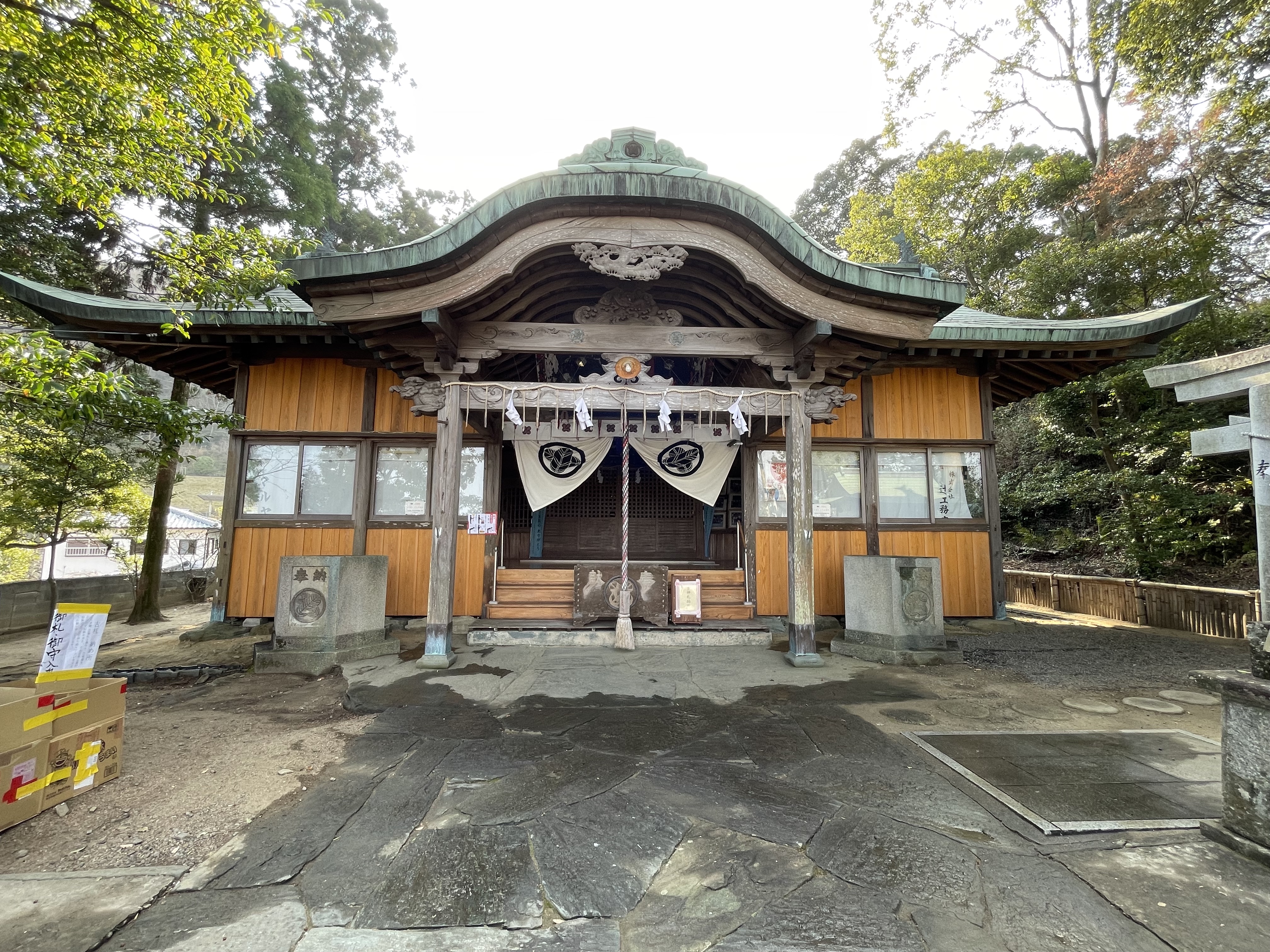How to Make Shrine Visits More Interesting
This article originally appeared in the February 2023 issue of CONNECT.
Faith Trend (Tokushima)
Tucked away down compact city streets and within rocky mountain crevices—wherever you go in Japan, you are never far from a Shinto shrine. One of the most famous is Kyoto’s Fushimi Inari Taisha, a sprawling complex with around 1,000 torii gates that meander their way up an entire mountain. However, with an officially estimated 80,000 public shrines dotted around the country, the majority of shrines are smaller and simpler, sometimes merely a single edifice with a torii gate or even just a small box-like structure in a small nook on the roadside (known as a hokora or miniature shrine).
Given the almost ubiquitous nature of both Shinto shrines and Buddhist temples in Japan, one could be forgiven for thinking, as many of my friends understandably do, “Aren’t they all basically the same?” As an enthusiast of these sorts of things, I would heartily disagree. In fact, I would argue each shrine has something fascinating to discover. To demonstrate this, I decided to write about some of the shrines in my home prefecture of Tokushima. I aim to provide some basics on what to see when visiting shrines and hopefully show points of interest at shrines both big and small.
A great starting point when visiting a new shrine is working out the kami it is connected with. Kami are the gods or spirits that are worshipped in the Shinto religion. They are animistic entities and can be found both throughout the natural world (from rivers and rocks, to thunder and lightning) and in the spirits of important ancestors. While there are technically millions of kami that can be venerated, the majority of shrines are dedicated to a handful of the most popular kami; shrines are usually easily identifiable once you know their tells. Even if you know very little Japanese, when you walk into a shrine, there are symbols that can help you recognise whether a shrine is dedicated to one (or more) of them.
Inari
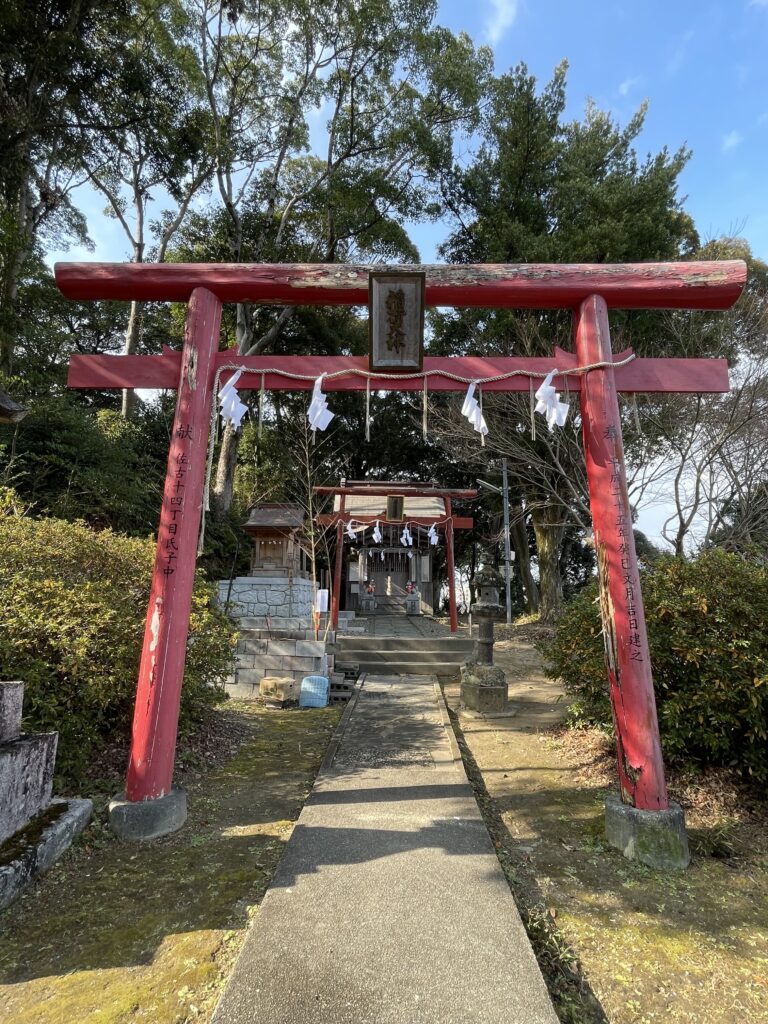 There are more shrines dedicated to the fox kami Inari than any other kami. Unsurprisingly, Inari’s popularity comes from being the kami of agriculture, industry, tea, rice, sake, and fertility. Foxes are believed to be Inari’s messengers. At some of the bigger shrines, inarizushi is a popular dish to buy at the stalls lining the way to the shrine entrances. Made of sushi rice enclosed inside sweet fried and boiled tofu, the corners of these sushi rolls are thought to look like fox ears, and tofu is believed to be Inari’s preferred snack. You might also spot bags of rice and bottles of sake left by worshippers at Inari shrines.
There are more shrines dedicated to the fox kami Inari than any other kami. Unsurprisingly, Inari’s popularity comes from being the kami of agriculture, industry, tea, rice, sake, and fertility. Foxes are believed to be Inari’s messengers. At some of the bigger shrines, inarizushi is a popular dish to buy at the stalls lining the way to the shrine entrances. Made of sushi rice enclosed inside sweet fried and boiled tofu, the corners of these sushi rolls are thought to look like fox ears, and tofu is believed to be Inari’s preferred snack. You might also spot bags of rice and bottles of sake left by worshippers at Inari shrines.
For me, a relatively local Inari shrine can be found amongst a cluster of other shrines on a small hill inside Tokushima City. Unlike the torii gates leading to the other shrines in this area, the gates for this shrine are a bright red (though now a little worse for wear). Red is an especially indicative colour for Inari shrines, and while torii gates on other shrines can also be red, red torii gates are most typically found at Inari shrines.
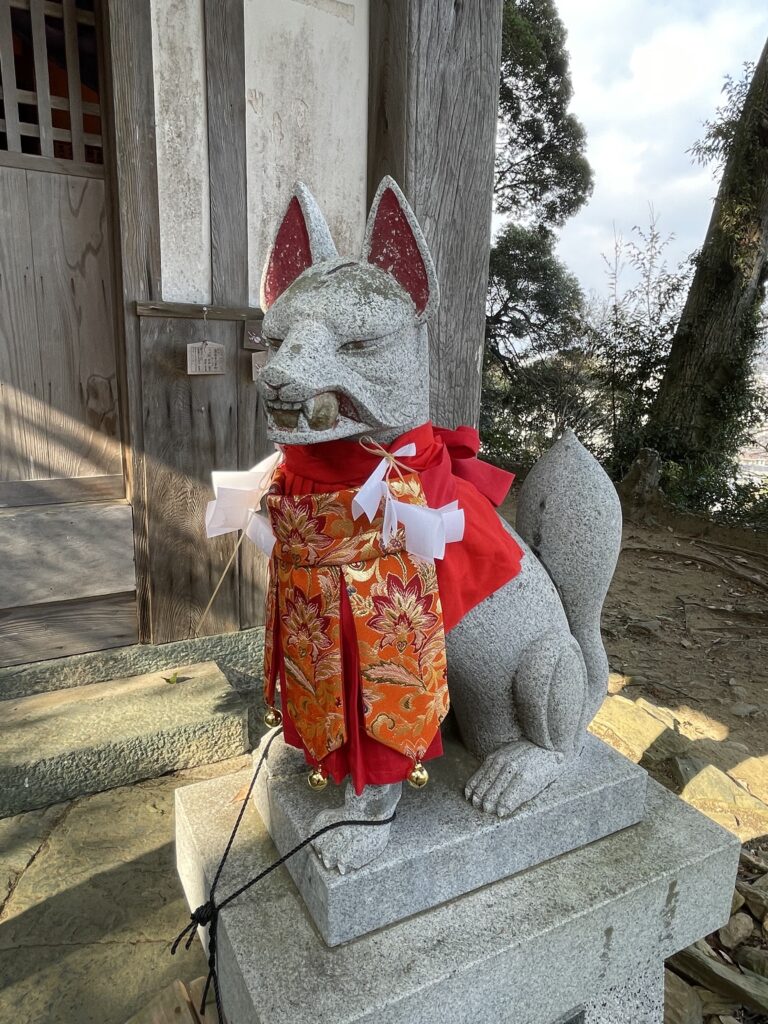 Further confirmation that it is an Inari shrine are the two fox statues placed either side of the wooden sanctuary. Inari fox statues guard the shrine from evil spirits and come in pairs—one female, the other male. They also tend to be holding something in their mouths or under one of their front paws. These items—keys, scrolls, fox cubs, jewels, sheaves of rice—are highly symbolic. Keys, for example, are meant to represent the key to the doors of a great celestial granary which stores all the harvests of the universe. Here, the left fox is carrying a scroll in its mouth while the one on the right is holding something rolled up into a ball, perhaps a fox cub. As it was just after the new year when I last visited this shrine, the red bibs that the Inari foxes typically wore were overlaid with additional jazzed-up bibs of ornately embroidered red and gold fabric with little bells attached.
Further confirmation that it is an Inari shrine are the two fox statues placed either side of the wooden sanctuary. Inari fox statues guard the shrine from evil spirits and come in pairs—one female, the other male. They also tend to be holding something in their mouths or under one of their front paws. These items—keys, scrolls, fox cubs, jewels, sheaves of rice—are highly symbolic. Keys, for example, are meant to represent the key to the doors of a great celestial granary which stores all the harvests of the universe. Here, the left fox is carrying a scroll in its mouth while the one on the right is holding something rolled up into a ball, perhaps a fox cub. As it was just after the new year when I last visited this shrine, the red bibs that the Inari foxes typically wore were overlaid with additional jazzed-up bibs of ornately embroidered red and gold fabric with little bells attached.
Although my local Inari shrine is a little weather worn, the foxes are still adorned to look their best. Beyond them, the architecture of the small sanctuary includes decent carvings of dragons, the likes of which can be seen at many other Shinto shrines. Dragons are important to Shinto as symbols of good fortune and happiness. They are water kami and, as such, you typically see carvings of them at the basins (or chozuya) where worshippers ritually cleanse themselves before approaching the shrine for prayer.
Hachiman
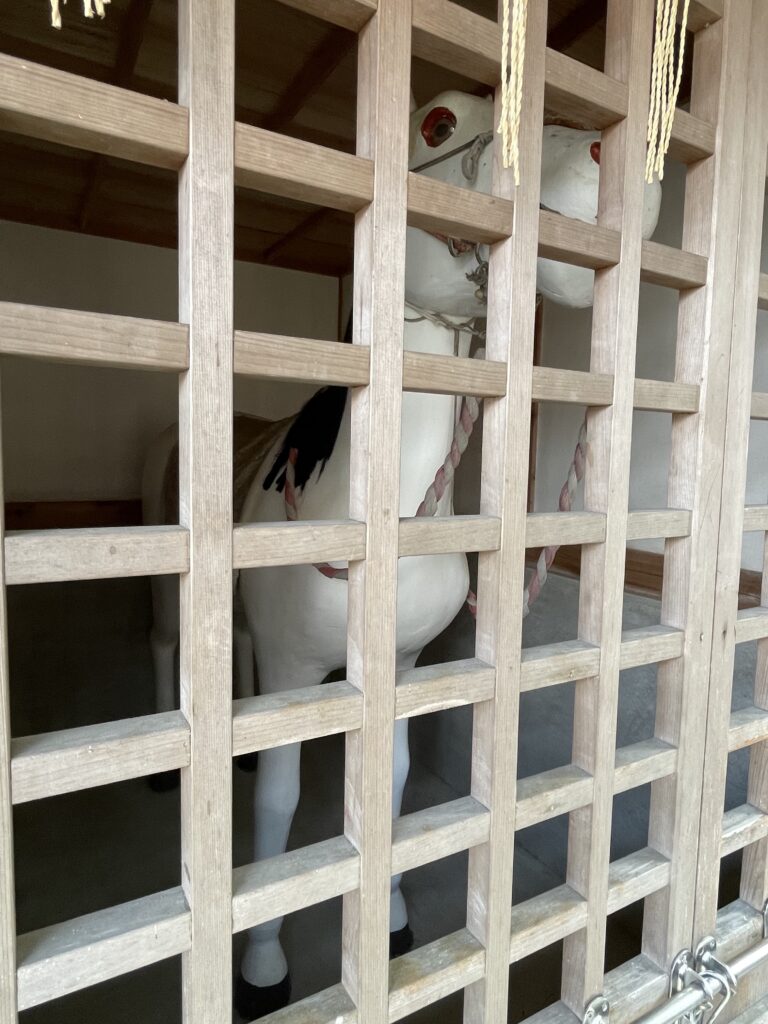 Following Inari shrines, Hachiman shrines are the second most popular type of Shinto shrine. Hachiman is the kami of war and warriors, andwas largely worshipped by the warrior class, the samurai. In general, most shrines hold an object called a shintai, which can either be a natural or manmade item. Shintai are meant to be repositories for the kami; they allow the kami to be accessible for worship. At Hachiman shrines, the shintai is often a military item such as a stirrup or a bow.
Following Inari shrines, Hachiman shrines are the second most popular type of Shinto shrine. Hachiman is the kami of war and warriors, andwas largely worshipped by the warrior class, the samurai. In general, most shrines hold an object called a shintai, which can either be a natural or manmade item. Shintai are meant to be repositories for the kami; they allow the kami to be accessible for worship. At Hachiman shrines, the shintai is often a military item such as a stirrup or a bow.
Given their importance in the time of the samurai, Hachiman shrines are often built quite large. Next to the little Inari shrine I stopped to visit, there was indeed a much larger Hachiman shrine. It had been recently restored and had two central buildings: a worship hall (haiden) that was accessible to all worshippers, and a further building called a honden which housed the shintai and was not typically open to the public. Instead of foxes, Hachiman shrines (and most other shrines) are accompanied by pairs of lion-dogs (shishi or komainu). Like the fox statues, the lion-dogs are meant to ward off evil spirits and thus are appropriate for protecting the entrances of shrines as well as temples. At the Hachiman shrine I visited, there were three shishi on each side of the shrine, all bedecked in clean white bibs for the new year.
 Here, the new year festivities have included the donation of some sake barrels (or kazari-daru). If you’ve ever been to Meiji-jingu in Tokyo, you’d have seen hundreds of sake barrels lining the route to the shrine. While the barrels on display at my local Hachiman shrine are typically empty, they represent a very real donation from a local brewery to be enjoyed at festivals later in the year.
Here, the new year festivities have included the donation of some sake barrels (or kazari-daru). If you’ve ever been to Meiji-jingu in Tokyo, you’d have seen hundreds of sake barrels lining the route to the shrine. While the barrels on display at my local Hachiman shrine are typically empty, they represent a very real donation from a local brewery to be enjoyed at festivals later in the year.
As you approach the honden to pray, a somewhat surprising sight awaits you: two large wooden tengu sculptures affixed to the ceiling beams. Tengu are a type of yokai, or supernatural creature, and can be worshipped as kami themselves, hence their inclusion here.
Another interesting surprise in between the Inari and Hachiman shrines can be found at a separate building. Inside it are two wooden horse sculptures, one black and one white. Horses have been connected with Shinto for 1,300 years, since it was thought they made the best sacrifices to the kami. It was believed that horses were intermediaries between the real and divine worlds and would be ridden by the kami when they entered the divine realm. Black horses would be sacrificed to shrines when the people wanted rain, while white horses were sacrificed when people prayed for rain to stop. Today, this practice has long since been replaced with the permanent dedication of horse sculptures, typically wooden or bronze. In some cases though, real horses can still be seen living at shrines, such as at Konpira-san in Kagawa Prefecture.
Tenjin
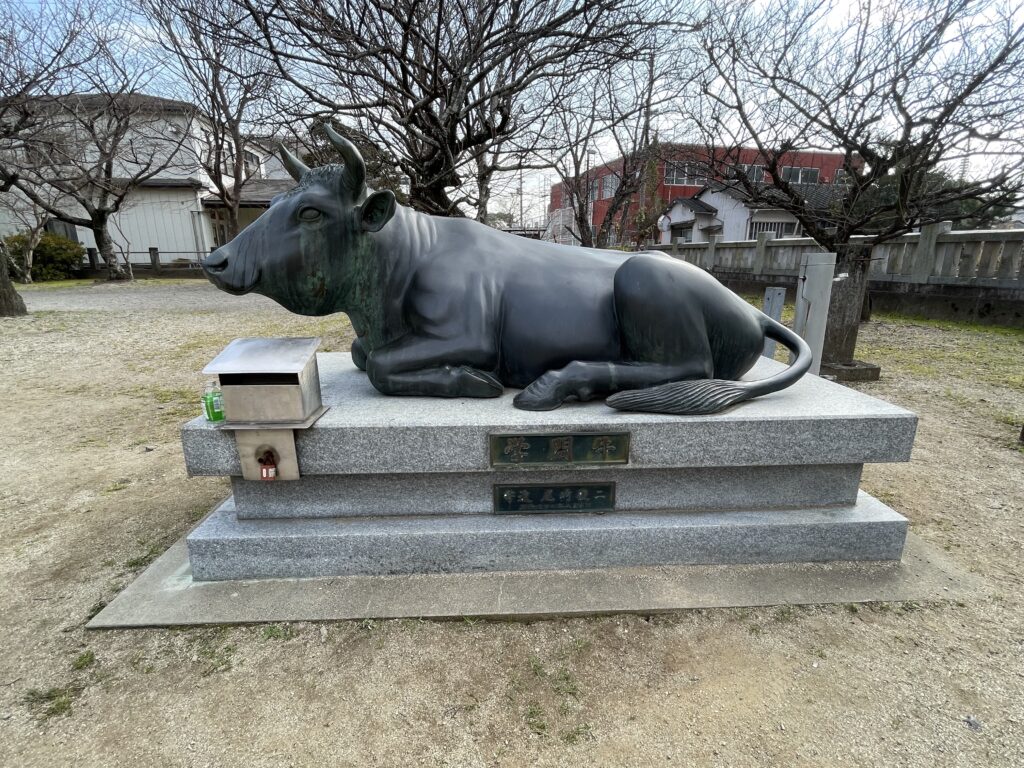 Another pertinent kami for all of those who are studying is the sky kami, Tenjin. Tenjin is the deified form of the famous 9th century scholar Sugawara no Michizane, and is naturally prayed to as the kami of learning. The main shrine dedicated to Tenjin is Kitano Tenmangu in Kyoto, a shrine popular with students in the city. Since plum trees were Michizane’s favourite, they can be found at Kitano Tenmangu and other Tenjin shrines, with various festivals taking place during plum blossom season (which also happens to be exam season!). According to legend, during Michizane’s funeral procession, a bull that had been pulling his coffin refused to go any further and it was at that spot that the first Tenjin shrine was built. Consequently, a feature common to Tenjin shrines is the statue of a bull that local students touch for good luck.
Another pertinent kami for all of those who are studying is the sky kami, Tenjin. Tenjin is the deified form of the famous 9th century scholar Sugawara no Michizane, and is naturally prayed to as the kami of learning. The main shrine dedicated to Tenjin is Kitano Tenmangu in Kyoto, a shrine popular with students in the city. Since plum trees were Michizane’s favourite, they can be found at Kitano Tenmangu and other Tenjin shrines, with various festivals taking place during plum blossom season (which also happens to be exam season!). According to legend, during Michizane’s funeral procession, a bull that had been pulling his coffin refused to go any further and it was at that spot that the first Tenjin shrine was built. Consequently, a feature common to Tenjin shrines is the statue of a bull that local students touch for good luck.
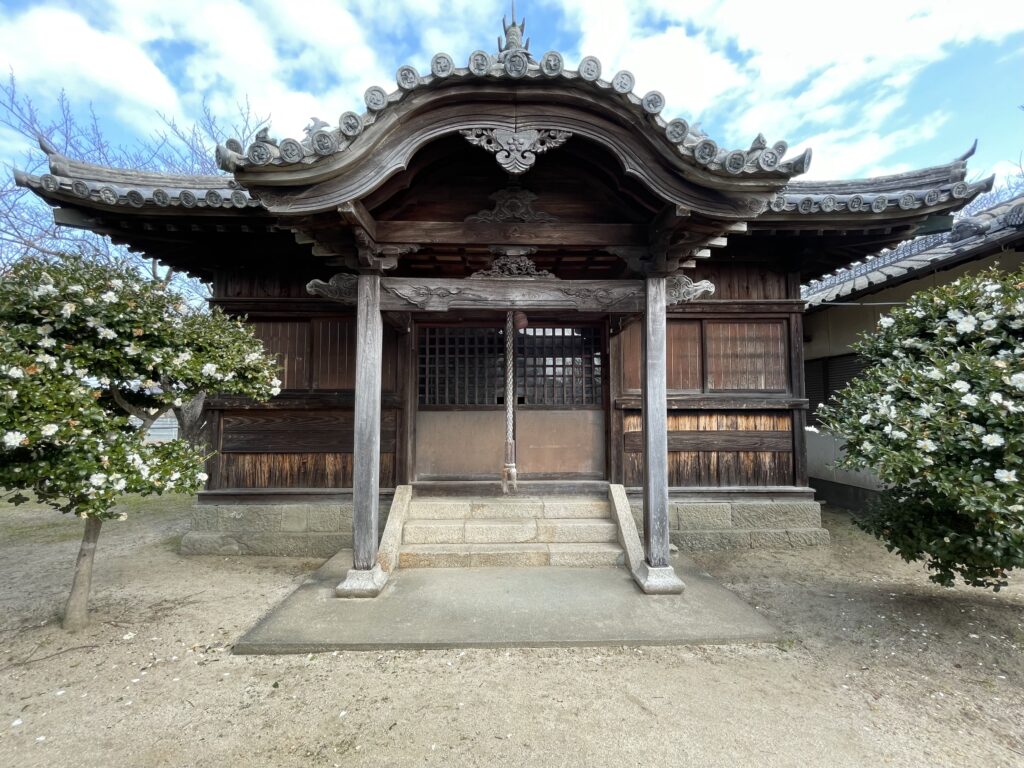 My local Tenjin shrine is indeed close to a number of schools. As you pass through its stone torii gate, there is a bull statue on the right, unmistakably dedicated to Tenjin. Nearby, there are an array of plum trees which, while firmly asleep right now, will no doubt flower in time for my town’s exam celebrations in early spring.
My local Tenjin shrine is indeed close to a number of schools. As you pass through its stone torii gate, there is a bull statue on the right, unmistakably dedicated to Tenjin. Nearby, there are an array of plum trees which, while firmly asleep right now, will no doubt flower in time for my town’s exam celebrations in early spring.
Although it is winter, there were also some white camellias flowering at this shrine. Camellias are often found at shrines because they are thought to have a special connection to the kami. They are thought to use them as their home when they visited the earthly realm.
Inari, Hachiman and Tenjin are just three of Shinto’s most popular kami. Others that you may have heard of might include Amaterasu, the sun kami; Raijin and Fujin, the kami of thunder and wind; and the shichifukujin, or the seven lucky gods. The more you learn about the kami, the more interesting a shrine visit can become. There are other features too that I have touched on, such as the planting of specific flowers and the inclusion of various animal forms, which all have significant symbolism in Shinto. Almost nothing at a Shinto shrine is there by accident. It has all been carefully designed and refined for thousands of years.
Faith is a second-year JET. She lives in Tokushima Prefecture and loves taking her trusty kei-car out to explore—stopping at shrines, temples, waterfalls, and interesting mountain paths along the way.
Image Credits
Faith Trend




